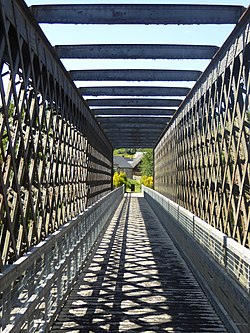Ballindalloch Railway Bridge
 From Wikipedia - Reading time: 3 min
From Wikipedia - Reading time: 3 min
Ballindalloch Railway Bridge | |
|---|---|
 The view along the bridge | |
| Coordinates | 57°24′50″N 3°23′08″W / 57.41389°N 3.38556°W |
| Carries | Pedestrians, cyclists (formerly railway) |
| Crosses | River Spey |
| Heritage status | Category A listed building |
| Characteristics | |
| Material | Wrought iron |
| Longest span | 195 ft (59 m) |
| History | |
| Architect | Alexander Gibb |
| Fabrication by | G McFarlane, Dundee |
| Opened | 1863 |
| Location | |
 | |
The Ballindalloch Railway Bridge is a former railway bridge on the crossing the River Spey at Ballindalloch in Moray, Scotland. Built in 1863 as a part of the Strathspey Railway, it was in use until the line was closed in 1968. It is now designated as a Category A listed building, and carries pedestrians and cyclists over the river as a part of the Speyside Way.
Description
[edit]The Ballindalloch Railway Bridge crosses the Spey at Ballindaloch, linking the parishes of Inveravon in Banffshire and Knockando in Moray.[1] It is a wrought iron lattice girder bridge, with a single-span of 195 feet (59 metres),[2] supported by rubble abutments, and with plate girder spans at either end giving an overall length of around 250 feet (75 metres).[3]
History
[edit]The Ballindalloch Railway Bridge was constructed in 1863 for the Strathspey Railway.[4] It was designed by Alexander Gibb,[2] an engineer for the Great North of Scotland Railway,[5] and the ironwork was fabricated by G. MacFarlane of Dundee.[2] The Strathspey Railway was absorbed into the Great North of Scotland Railway in 1866,[6] and the bridge was in regular use on the line, carrying passengers and large volumes of whisky from the nearby distilleries,[3] until it was closed to regular passenger traffic in 1965, and closed completely in 1968.[7] The bridge was designated a Category A listed building in 1987, and was a scheduled monument until 2006.[3] It is open to pedestrians and cyclists, forming a part of the Speyside Way.[3]
References
[edit]- ^ "Railway Bridge over the Spey". Dictionary of Scottish Architects. Dictionary of Scottish Architects. Retrieved 7 July 2019.
- ^ a b c Paxton, Roland; Shipway, Jim (2007). Civil Engineering Heritage - Scotland Highlands and Islands. ICE Publishing. pp. 135–136. ISBN 978-0727734884. Retrieved 7 July 2019.
- ^ a b c d Historic Environment Scotland. "Ballindalloch, former railway bridge over River Spey (Category A Listed Building LB8466)". Retrieved 7 July 2019.
- ^ Hume, John R (1977). The Industrial Archaeology of Scotland 2. The Highlands and Islands. London: B.T. Batsford Ltd. p. 234. ISBN 071340809X.
- ^ Paxton, Roland; Shipway, Jim (2007). Civil Engineering Heritage - Scotland Highlands and Islands. ICE Publishing. ISBN 978-0727734884. Retrieved 7 July 2019.
- ^ Vallance, H. A. (27 June 1991). Great North of Scotland Railway. The History of the Railways of the Scottish Highlands Vol. 3. David St John Thomas. ISBN 978-0-946537-60-0.
- ^ "Ballindalloch, Railway Bridge". CANMORE. Historic Environment Scotland. Retrieved 7 July 2019.
 KSF
KSF